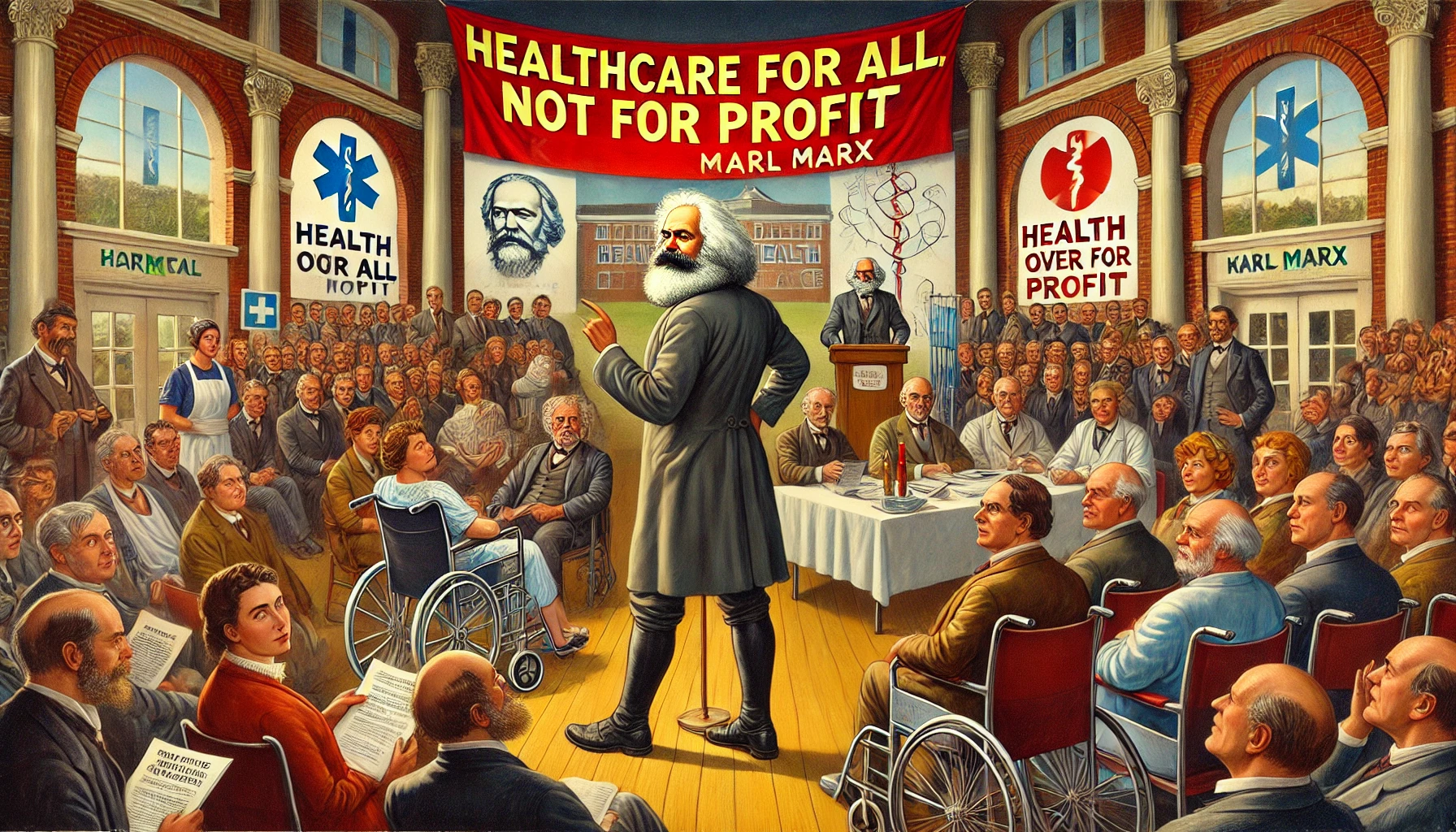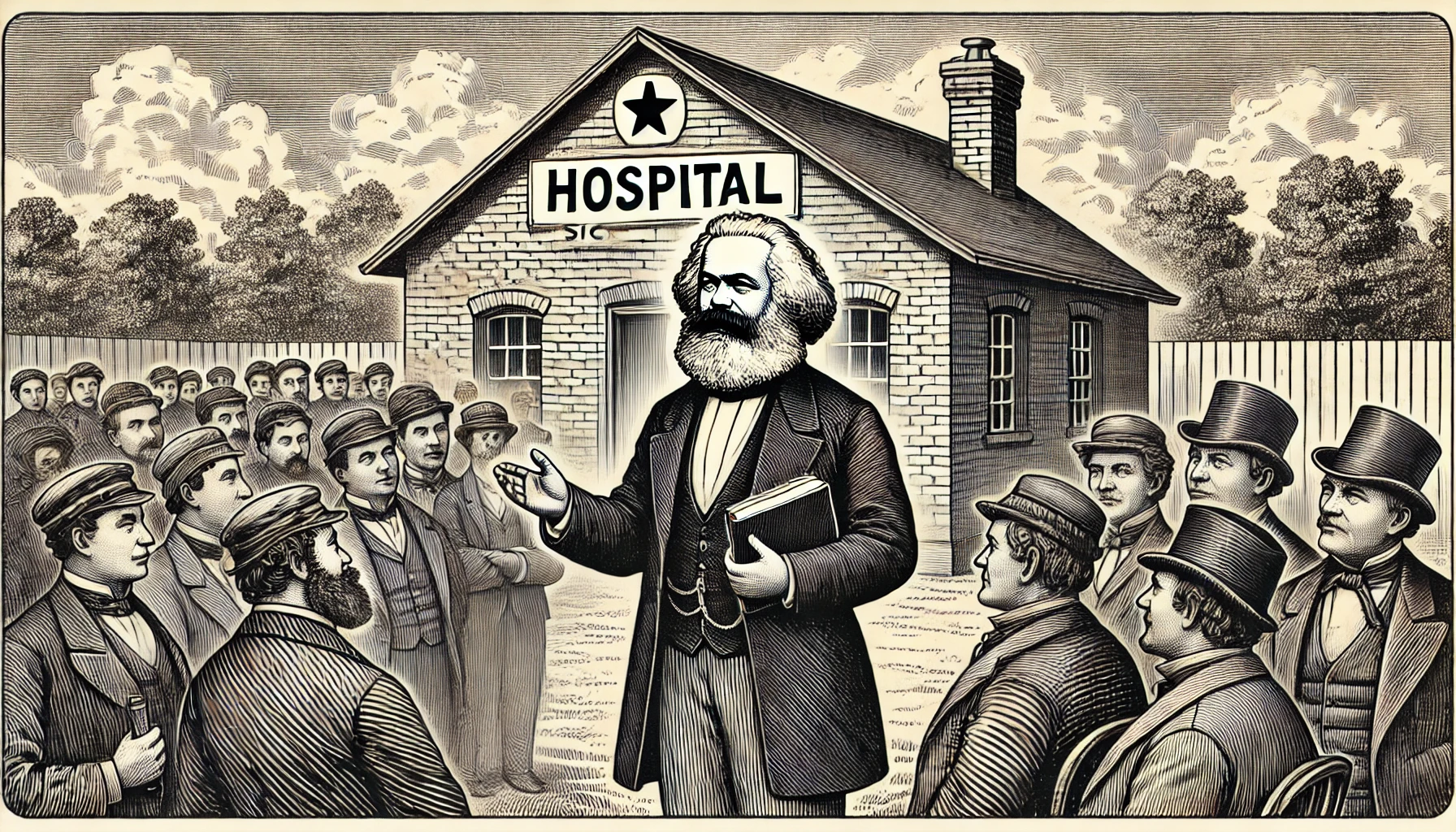What Would Lenin Be Doing Today to Undermine Private Health Insurance?
Vladimir Lenin, the architect of Soviet socialism, was a master strategist when it came to dismantling capitalist institutions and building a socialist society. Were he alive today, Lenin would undoubtedly see private health insurance as a quintessential capitalist structure ripe for elimination. Private health insurance, from a Leninist perspective, epitomizes the profit-driven exploitation of basic human needs, creating inequality, and enriching a few at the expense of many. Lenin’s historical methods—exposing institutional failures, undermining public confidence, leveraging crises, and galvanizing mass movements—offer a blueprint for how he might target private health insurance today.
This essay explores how Lenin’s tactics could be applied in a modern context to undermine private health insurance, drawing parallels to his strategies for dismantling other capitalist systems in the early 20th century. It also examines how these methods would likely play out in today’s interconnected, media-driven, and highly polarized world.
1. Exposing the Failures of Private Health Insurance
Lenin’s strategy often began with highlighting the failures of capitalist institutions, exposing how they perpetuate inequality and fail to meet the needs of the working class. In today’s context, private health insurance provides ample fodder for such critiques. Rising premiums, exorbitant deductibles, denial of life-saving treatments, and medical bankruptcies are common grievances. Lenin would likely focus on these failures to paint private health insurance as irredeemable.
Amplifying Individual Stories
One of Lenin’s strengths was his ability to translate systemic issues into personal stories that resonated with the masses. Modern examples abound: patients dying because their insurance denied coverage for costly procedures, families bankrupted by medical bills despite being insured, or seniors unable to afford life-sustaining medications. Lenin would seize on these stories, using them as powerful tools to illustrate the moral and functional bankruptcy of private health insurance.
Data-Driven Critiques
Lenin was also a pragmatist who relied on data to bolster his arguments. Today, he would likely cite statistics showing that the U.S. spends more on healthcare per capita than any other country yet ranks poorly in health outcomes such as life expectancy and infant mortality. He might highlight studies showing that administrative costs in private health insurance far exceed those in single-payer systems like Canada’s or the UK’s National Health Service (NHS). Such data would underscore the inefficiency and inequity of private health insurance, bolstering the case for systemic change.
2. Undermining Public Confidence in Private Health Insurance
Lenin understood that revolutionary change required a shift in public consciousness. He would target public trust in private health insurance, framing it as a system designed to exploit rather than serve. His goal would be to convince people that reform is impossible and that the system must be dismantled entirely.
Leveraging Media and Social Platforms
In Lenin’s time, newspapers and pamphlets were the primary tools for disseminating revolutionary ideas. Today, he would undoubtedly leverage social media to spread his message. Platforms like Twitter, Facebook, and TikTok would become battlegrounds where Leninist activists share viral videos, infographics, and hashtags exposing the inequities of private health insurance. Stories of denied claims or soaring premiums would be amplified to sow doubt about the system’s legitimacy.
Targeting Insurance Executives
Lenin often personalized his critiques, targeting individuals who symbolized systemic oppression. In the context of private health insurance, he might focus on the CEOs of major companies like UnitedHealthcare or Anthem, highlighting their multimillion-dollar salaries and bonuses while policyholders struggle to afford care. These figures would become symbols of greed and exploitation, rallying public anger against the system.
3. Exploiting Crises to Push for Systemic Change
Lenin thrived on crises, seeing them as opportunities to advance revolutionary goals. In today’s world, the COVID-19 pandemic would have been a golden opportunity for Lenin to critique private health insurance. The pandemic exposed glaring gaps in the U.S. healthcare system, from overwhelmed hospitals to millions losing coverage after losing their jobs.
The Pandemic as a Catalyst
Lenin would likely argue that the pandemic proved the inadequacy of a healthcare system tied to employment. He might highlight cases of uninsured COVID-19 patients facing astronomical hospital bills or essential workers unable to access affordable care. These narratives would be used to build momentum for a transition to universal healthcare.
Climate Change and Health
Lenin would also likely connect healthcare to broader crises like climate change. For example, he might emphasize how climate-related disasters exacerbate health inequalities, with low-income communities suffering the most. By framing private health insurance as ill-equipped to address these systemic challenges, Lenin could make a compelling case for a more centralized, state-run system.
4. Galvanizing Mass Movements
Lenin was a master of mobilizing grassroots movements, rallying workers, peasants, and soldiers to his cause. In the modern era, he would likely support and amplify movements advocating for healthcare reform, such as Medicare for All in the United States.
Building Coalitions
Lenin would understand the importance of building broad coalitions to advance his agenda. He would likely ally with labor unions, progressive politicians, and advocacy groups to create a unified front against private health insurance. Campaigns might focus on accessible slogans like “Healthcare is a Human Right” or “Profits Over People” to galvanize public support.
Targeting Vulnerable Demographics
Lenin’s focus on the working class would extend to today’s uninsured and underinsured populations, as well as gig workers and freelancers who lack employer-provided benefits. By framing healthcare reform as a class struggle, Lenin could tap into the frustrations of these groups, turning them into vocal advocates for systemic change.
5. Policy Proposals and Alternatives
Lenin was not just a critic but also a visionary who offered concrete alternatives to the systems he sought to dismantle. In today’s context, he would likely advocate for a single-payer healthcare system, emphasizing its benefits over the fragmented, profit-driven model of private health insurance.
Single-Payer Healthcare
Lenin would champion a system where the government finances healthcare through taxes, eliminating the role of private insurers. He would argue that this model reduces administrative costs, ensures universal coverage, and prioritizes patient care over profit.
Technology and Innovation
Lenin might also explore how technology can be harnessed to improve healthcare delivery. For example, he could advocate for the development of publicly funded telemedicine platforms or AI-driven diagnostics, framing these innovations as tools to democratize access to care.
6. Critiquing Reformist Approaches
Lenin was deeply skeptical of reformist approaches, viewing them as insufficient to address the root causes of inequality. He would likely critique incremental reforms in healthcare, such as expanding Medicaid or introducing public options, as half-measures that preserve the underlying capitalist system.
Exposing the Limitations of Reforms
Lenin would argue that reforms often create the illusion of progress while leaving the core problems intact. For instance, he might point out that a public option competing alongside private insurers could still leave millions uninsured and fail to address the profit motive driving healthcare costs.
The All-or-Nothing Approach
Lenin’s insistence on systemic change would likely manifest in calls for the complete abolition of private health insurance. He would frame this as a moral imperative, arguing that healthcare should be treated as a public good, not a commodity.
7. Dealing with Opposition
Lenin was no stranger to opposition, and he would likely face fierce resistance from private health insurance companies, lobbyists, and conservative politicians. His approach would involve both countering their arguments and exposing their vested interests.
Countering Economic Arguments
Opponents of universal healthcare often argue that it is too expensive or stifles innovation. Lenin would counter these claims by pointing to the inefficiencies and inequalities of the current system, as well as examples of successful single-payer systems in other countries.
Exposing Lobbying Efforts
Lenin would likely shine a spotlight on the lobbying efforts of private health insurers, emphasizing their influence on policymaking and their role in maintaining the status quo. By framing these companies as corrupt entities prioritizing profits over people, he could undermine their credibility and sway public opinion.
8. Social Media as a Modern Tool
In Lenin’s time, pamphlets and newspapers were the tools of revolution. Today, social media offers a far more powerful platform for spreading ideas and mobilizing support.
Hashtag Campaigns
Lenin might launch campaigns with hashtags like #EndPrivateInsurance or #HealthcareForAll, using viral content to reach a broad audience. Infographics, videos, and personal stories would be central to these efforts.
Engaging Influencers
Lenin would likely enlist the help of progressive influencers, celebrities, and activists to amplify his message. By partnering with high-profile figures, he could reach diverse demographics and build momentum for his cause.
9. The Ethical and Moral Argument
Lenin’s critique of capitalism was not just economic but also moral. He would frame private health insurance as a system that commodifies human life, prioritizing profits over people’s well-being.
Healthcare as a Human Right
Lenin would argue that healthcare is a fundamental human right and that any system denying access to care is inherently unjust. This moral framing would resonate deeply with those who view healthcare as an ethical issue rather than a policy debate.
The Cost of Inaction
Lenin would emphasize the human cost of maintaining the current system, from preventable deaths to the financial ruin of families facing medical crises. By highlighting these consequences, he could make a compelling case for immediate action.
Conclusion: Lenin’s Blueprint for Dismantling Private Health Insurance
Were Lenin alive today, he would see private health insurance as a prime target in his broader struggle against capitalism. His tactics—exposing systemic failures, undermining public confidence, leveraging crises, galvanizing mass movements, and proposing transformative alternatives—offer a roadmap for dismantling this institution.
While Lenin’s methods were often polarizing and controversial, they were undeniably effective in advancing his vision of a socialist society. In the context of healthcare, his critique of private health insurance would challenge the status quo, forcing a reckoning with the moral and practical shortcomings of a profit-driven system. Whether one agrees with his ideology or not, Lenin’s approach offers valuable insights into the ongoing debate over the future of healthcare.

Originally posted 2024-07-10 20:07:22.



